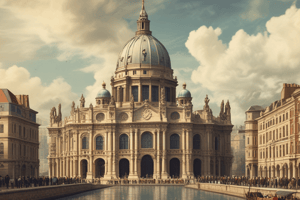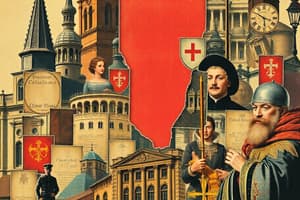Podcast
Questions and Answers
Flashcards
საშუა საუკუნეების დასაწყისი: ცვლილებები
საშუა საუკუნეების დასაწყისი: ცვლილებები
საშუა საუკუნეების დასაწყისში, ევროპის ისტორიაში მნიშვნელოვანი ცვლილებები დაიწყო.
კაროლინგების იმპერიის დაშლა
კაროლინგების იმპერიის დაშლა
კაროლინგების იმპერიის დაშლის შემდეგ, ოტონების მემკვიდრეებმა იტალიასა და გერმანულ საგრაფოებთან ურთიერთობის გაწყვეტა დაიწყეს.
ქრისტიანობა და ფეოდალიზმი
ქრისტიანობა და ფეოდალიზმი
ქრისტიანული ეკლესია და ფეოდალიზმი ამ დროისთვის მჭიდროდ იყო დაკავშირებული.
ფეოდალიზმი: ეკონომიკური სისტემა
ფეოდალიზმი: ეკონომიკური სისტემა
Signup and view all the flashcards
მბრძანებლები: მიწის საკუთრება
მბრძანებლები: მიწის საკუთრება
Signup and view all the flashcards
ციხესიმაგრეები: ძალაუფლების სიმბოლო
ციხესიმაგრეები: ძალაუფლების სიმბოლო
Signup and view all the flashcards
რომანული ბარონი: ჰეროიკული ტრადიციის მემკვიდრე
რომანული ბარონი: ჰეროიკული ტრადიციის მემკვიდრე
Signup and view all the flashcards
მონასტიციზმი: ცალკევობა და სულიერი განვითარება
მონასტიციზმი: ცალკევობა და სულიერი განვითარება
Signup and view all the flashcards
რომანული ორდენები: რეფორმები
რომანული ორდენები: რეფორმები
Signup and view all the flashcards
კლუნის ორდენი: რეფორმა და ცენტრალიზაცია
კლუნის ორდენი: რეფორმა და ცენტრალიზაცია
Signup and view all the flashcards
ციტერციანული ორდენი: რწმენა შრომის მეშვეობით
ციტერციანული ორდენი: რწმენა შრომის მეშვეობით
Signup and view all the flashcards
ფეოდალური განლა... საზ ...
ფეოდალური განლა... საზ ...
Signup and view all the flashcards
კონფლიქტი: papebsა და ფეოდა ...
კონფლიქტი: papebsა და ფეოდა ...
Signup and view all the flashcards
პილიგრიმობა და ლაშქრობ ...
პილიგრიმობა და ლაშქრობ ...
Signup and view all the flashcards
წმინდა ადგილებში მოგზაურობ ...
წმინდა ადგილებში მოგზაურობ ...
Signup and view all the flashcards
ნაગებობების აღდგენ ...
ნაગებობების აღდგენ ...
Signup and view all the flashcards
ლანგედოკი-ბურგუნდია: წმინდა სერნენის ტაძარი
ლანგედოკი-ბურგუნდია: წმინდა სერნენის ტაძარი
Signup and view all the flashcards
სენ სერნენი: რომ ...
სენ სერნენი: რომ ...
Signup and view all the flashcards
გერმანია-ლომბარდია: სპეიერის ტაძარი
გერმანია-ლომბარდია: სპეიერის ტაძარი
Signup and view all the flashcards
სპეიერი: ტა ...
სპეიერი: ტა ...
Signup and view all the flashcards
ლომბარდიის არქიტექტურა: სან ამბროჯიო
ლომბარდიის არქიტექტურა: სან ამბროჯიო
Signup and view all the flashcards
სან ამბროჯიო: რომ ...
სან ამბროჯიო: რომ ...
Signup and view all the flashcards
ნორმანდია-ინგლისი: კანის სენ...
ნორმანდია-ინგლისი: კანის სენ...
Signup and view all the flashcards
კანის სენ ეტიე... რომ ...
კანის სენ ეტიე... რომ ...
Signup and view all the flashcards
დერჰემი: რომ ...
დერჰემი: რომ ...
Signup and view all the flashcards
დერჰემი: რომ ...
დერჰემი: რომ ...
Signup and view all the flashcards
ტოსკანა: რომ ...
ტოსკანა: რომ ...
Signup and view all the flashcards
ტოსკანა: რომ ...
ტოსკანა: რომ ...
Signup and view all the flashcards
გოთიკა: ზოგ ...
გოთიკა: ზოგ ...
Signup and view all the flashcards
გოთიკა: ტერ ...
გოთიკა: ტერ ...
Signup and view all the flashcards
გოთიკა: საზ ...
გოთიკა: საზ ...
Signup and view all the flashcards
გოთიკა: რომ ...
გოთიკა: რომ ...
Signup and view all the flashcards
გოთიკა: ტა ...
გოთიკა: ტა ...
Signup and view all the flashcards
გოთიკა: კონ...
გოთიკა: კონ...
Signup and view all the flashcards
სენ დენი: პა ...
სენ დენი: პა ...
Signup and view all the flashcards
გოთიკური კონ ...
გოთიკური კონ ...
Signup and view all the flashcards
გოთიკური ტაძ...
გოთიკური ტაძ...
Signup and view all the flashcards
ლანი: გო...
ლანი: გო...
Signup and view all the flashcards
Study Notes
History of Western European Architecture
- The book covers the history of Western European architecture from the Romanesque era to the beginning of the 19th century.
- The book examines the stylistic changes in architecture during this period, highlighting specific styles like Romanesque, Gothic, Renaissance, Baroque, Classicism, and Empire.
- It presents illustrative material complementary to the text, focusing on key architectural features and examples across various locations in Europe.
- Key examples of buildings discussed include cathedrals and other religious structures in France, Germany, Normandy, and Italy.
- The role of artistic styles, such as sculptures and paintings, in enhancing the aesthetic qualities of buildings is also analyzed.
Romanesque Period
- Significant changes occurred in European history from the mid-11th century onward. Earlier periods were characterized by turmoil from barbarian migrations.
- Consolidation of settlements into imperial structures, like those of the Carolingians and Ottonians, happened. These were rooted in the Roman Empire's traditions.
- The study of classic knowledge was revived due to contacts with the Islamic world and the resumption of commerce.
- Construction was fueled by pilgrimages, the Crusades, and city growth, and also the rebuilding of sites damaged by the North Germanic barbarians.
- Essential challenges for architects in this period included the design of buildings able to accommodate large gatherings of people, as well as ensuring structures' strength, safety, and suitable acoustics.
- The prevalence of stone structures in Romanesque architecture compared to the often flammable timber roofs of the previous era was a critical technical advancement.
Gothic Period
- Significant developments and shifts in consciousness occurred during the transition from Romanesque to Gothic styles in the medieval period.
- The societal shift was attributed to the rise of the bourgeoisie, whose growing wealth influenced cultural preferences.
- The feudal structure of society persisted, becoming more organized and hierarchical with a stronger monarchy overseeing the lower feudal lords and the Church.
- Urban centers often grew and strengthened, leading to the rise of substantial urban entities, independent of feudal control, along with a flourishing middle class in the cities.
- These socioeconomic changes fostered a new self-awareness and potential in Western Europe.
- The Church still exerted significant influence, though, it wasn’t able to satisfy the growing intellectual thirst of the populace. The resurgence of classical knowledge exerted an important influence too.
- The responsibility for constructing churches shifted from monastic workshops to lay craftspeople, which contributed to the emergence of specialized workshops.
- Critical aspects of Gothic construction included the replacement of thick, solid walls with a skeletal support system involving ribs and flying buttresses.
- This allowed for higher ceilings with stained-glass windows, providing ample natural light. The greater height of Gothic structures marked a crucial change from the horizontal Romanesque designs.
- The development and mastery of ribbed vaults, flying buttresses, and stained-glass windows were key to the Gothic style.
- Structures in France, including Saint-Denis, the Cathedral of Notre Dame in Paris, and the Cathedral of Chartres, became models for Gothic architecture throughout Europe.
Renaissance
- The rise of a new social and cultural impulse, known as the Renaissance.
- The initiative started in Northern Italy due to a set of favorable socio-economic conditions.
- These conditions facilitated the breaking away from feudal structures and the emergence of independent city-states.
- The growing commercial dominance of northern Italian city-states brought wealth through trade with the East.
- The decline of feudal hierarchies and increased power of city-states.
- Emergence of humanistic values, intellectual pursuits, and artistic innovation.
- Revival of interest in classical learning and artistic forms.
- Shifting societal dynamics led to more important civic structures and a greater emphasis on human individuality and artistic creativity in comparison with the religiously-centered designs of the medieval period.
- This period saw the development of more secular buildings and civic structures, with a renewed focus on the human form and experience.
- The development of the dome, as seen in Brunelleschi's design for the Cathedral of Florence's Duomo, was a critical innovation in Renaissance architecture.
Baroque
- The book examines the characteristics of Baroque architecture, including increased theatricality and emotionality.
- The book highlights the work of influential Baroque architects such as Bernini and Borromini, who are connected with significant monumental structures such as St. Peter's Square and churches in Rome.
- The book details the changes and developments of architecture in this period
- The changing role of patrons, such as the Church, in the context of the spread of the Counter-Reformation, and the new importance of monumental displays of power, also feature strongly.
Classicism
- A period emphasizing symmetry, order, and restraint in architecture.
- The book examines the work of influential Classicist architects, such as Claude Perrault and Louis Le Vau, who are associated with structures like the Louvre and Versailles.
Studying That Suits You
Use AI to generate personalized quizzes and flashcards to suit your learning preferences.




